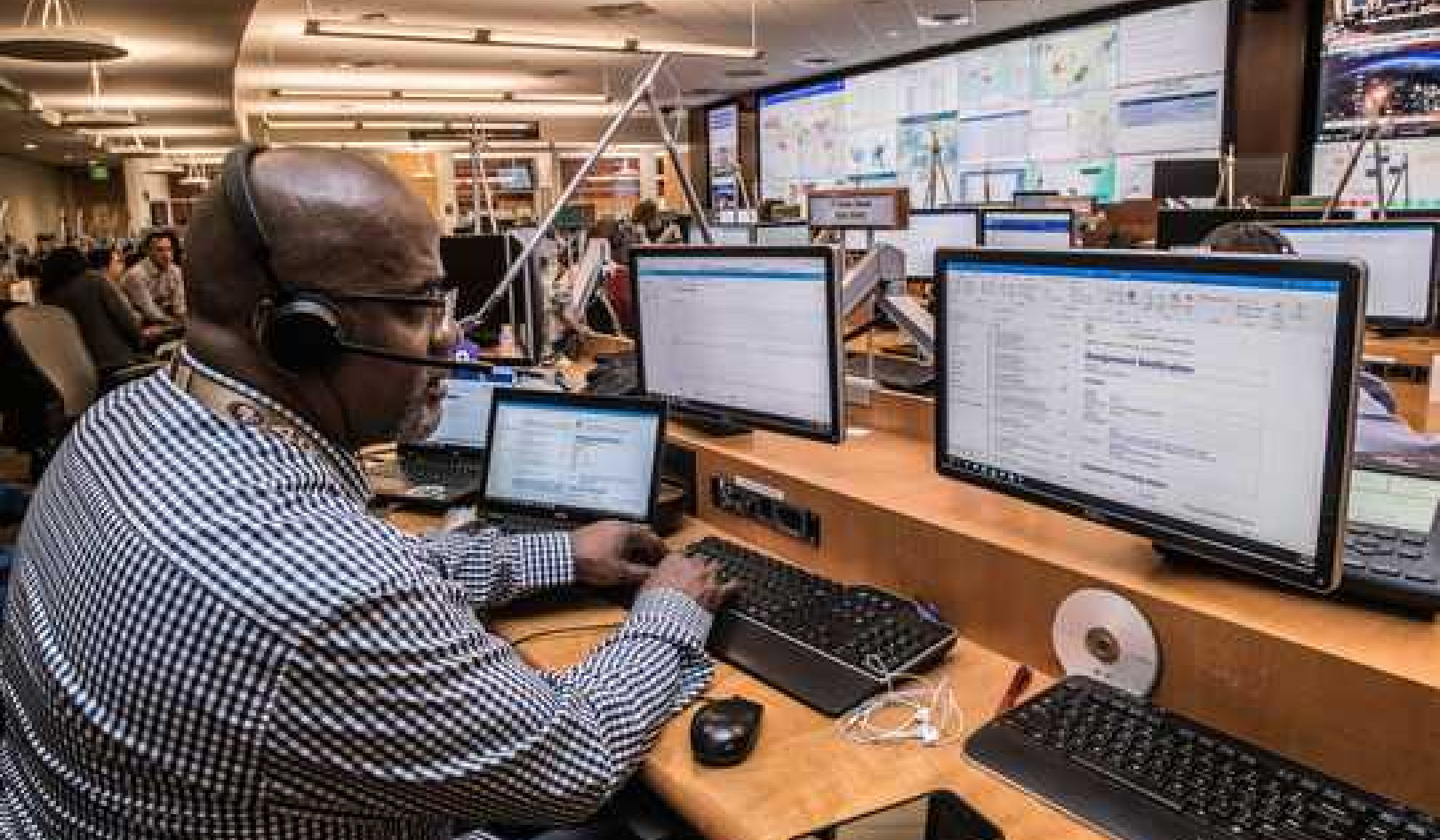
If you tell life
what it has to be,
you limit it.
If you let it show you
what it wants to be,
it will open doors
you never knew existed.
— Rutter-Rhymer
Years ago on one of their many trips together, my parents found a whimsical wall hanging made of three ceramic tiles inscribed with the words above. My father pointed out the hanging to my mother and said to her quietly, “That looks like Alan. That’s what he’s teaching us.”
Some months later as my father presented the wall hanging to me as a Christmas gift, he told the story of finding it and recognizing me in it. He went on to say that reading those words helped him more fully understand what my work was all about. His story alone was already a great gift to me. Today, the ceramic tiles hang in the entranceway to my office as a playful reminder of this simple truth, as well as of my father’s enduring presence in my life and work.
A Simple and Profound Approach to Life
The simple yet profound concept inscribed on those ceramic tiles is not one that most of us have been taught. How many times have you been told that you should have a clear picture of what you want, set goals to get there, design a plan to make it happen, and then actively implement your plan?
There is nothing wrong with setting goals, making plans, and then moving into action! Having a sense of direction and actively moving forward in that direction are essential if you want to make a meaningful difference in the world.
However, telling life what it has to be and then doing whatever it takes to make that happen can significantly limit our possibilities. It can also lead to a lot of unnecessary pressure and stress.
Not only is there an easier way—there is also a more productive and fulfilling way that can bring results far beyond anything we could have imagined. It’s not magic or a secret formula. It’s just a different approach than what many of us have been taught. It starts with the awareness that your circumstance, situation, or project probably has something to say to you—that it has information that can be helpful to you, and that can guide you forward.
What Wants To Happen Here?
Instead of “pushing against” our circumstance or trying to manipulate it into something else, the idea is to step back and pay attention to what is happening underneath the surface. Chances are there is a message that will give you clues about your next steps.
Also remember that “flow with” is not the same thing as “go with the flow.” “Go with the flow” is choosing to give in to whatever is currently happening. When we do this, we stop taking responsibility for what is happening and just let the situation unfold as it will. In some circumstances, that might be OK, yet in others, as you have probably experienced, it doesn’t turn out so well.
“Flow with” is a proactive approach that starts with tapping into the greater potential waiting to unfold—“what wants to happen” in service of something bigger than you or your organization—and following that potential towards a greater outcome.
If we pause to pay attention to the signals, there are messages everywhere. And if we pay attention to those messages and remain curious and open-minded, they will show us the way forward, even when things are breaking open, even in a VUCA world (volatile, uncertain, complex, and ambiguous).
Are You Pushing Against Life?
Just as the message on the ceramic tiles says, most of us have been conditioned to talk to life (push against) much more than to let life talk to us (flow with). In other words, we tell life what we want it to be, we tell our situations what we think needs to happen, and we control our experiences as much as possible so that we remain safely within our comfort zones.
So let’s bring the Three Questions and the Three Principles together in practical application. Consider a challenge or an opportunity that is showing up in your life or work right now. Pause from your reading just long enough to choose your “topic.” Then once you have chosen your topic, continue reading as if you and I were having a mini-coaching session. When I ask a question, pause your reading just long enough to answer the question, and then continue on. You can also find a video that will lead you through this mini-coaching process at TransformationalPresenceBook.com.
Let’s begin this mini-coaching session by looking at how you are approaching your topic. At the most fundamental level, are you talking to it—telling it what you need or want and trying to make something happen—or are you stepping back to listen and invite your topic to talk to you?
Whatever your answer is, it’s OK. We’re just gathering information. Our first objective in this exploration is to notice the general direction of your communication. Is the communication flowing mostly from you to your topic, or from your topic to you?
When we’re in “push against” mode, we’re talking to it, and often we’re trying to make something happen. Our “manipulation” may be very subtle, yet if we are honest with ourselves, it’s there. When we’re in “flow with” mode, we’re much more receptive and can let the topic talk to us.
Notice what happens in your relationship to your topic when you let it talk to you. Don’t worry about how to do that—just assume that you know how and see what happens. Let the communication come in whatever way feels the most natural for you. You might sense or feel something, you might get visual images, or you might hear words or phrases. Or perhaps even some combination of all three. Again, take your time.
As you gather information from your topic, resist the temptation to respond by telling it what you want or what you think. Continue to be curious. Ask another question and give your topic time to respond. Ask your topic what it wants you to know. Ask it to show you what’s important to pay attention to right now. Let your topic show you something that you haven’t yet realized—something that wants to happen or a potential that is waiting to emerge.
Pause from your reading. What are you discovering? What is shifting in your relationship to your topic and your understanding of it? Take your time, and continue with our mini-coaching session when you are ready.
Now leave that topic and consider a goal or a project that you want to accomplish. Pay attention again—have you been talking to it, or asking it to talk to you? Be honest with yourself and make no judgments. You’re just gathering information. If you recognize that the energy has been flowing primarily from you to the project, turn that around. What does the project want to say to you? Who is it asking you to be? What is it asking you to do? Just notice what information is available. And notice what is shifting in your relationship to the project as you open this communication flow. Again, take your time.
When you are ready, leave that goal or project and choose a relationship that is important to you. Bring in the relationship itself, not just the other person or people. The relationship has its own space and energy. Notice your habitual way of being with this relationship. Do you tell the relationship what you want it to be? Do you impose your energy and wishes on the relationship, or do you let the relationship talk to you?
You might want to take a few minutes to reflect on your insights from this exploration before you continue reading.
Output Mode or Input Mode?
When I lead this exploration in a workshop, most participants discover right away that their habitual approach is to talk to their topic. We have been conditioned to operate primarily in “output” mode—to talk to people, circumstances, situations, challenges, or possibilities. We are rewarded for making things happen, fixing what is not working, and getting results.
For most of us, stepping back, listening, and observing—stepping into “receptive” mode—has not been a part of our training. The invitation of Transformational Presence is to be in a receptive and interactive space—to enter fully into dialogue with our circumstances and situations and to let them talk to us.
Even when a few participants acknowledge the value of letting their challenge or situation talk to them, they still admit that, too often, the pressure or inner desire to get to an outcome quickly overrides their inner knowing. Our conditioning to make something happen or create a specific result is really strong!
Carolyn, a high-level executive, shared her insights and discoveries. “Through this exercise, I’m realizing that when I accept responsibility for something, I usually feel like I must control what happens. Other people are counting on me. So I talk to the situation and even sometimes try to force an outcome that I think is best. However, through this exercise, I’m discovering a whole new way of being responsive. I’m starting to understand that I can probably be more effective and impactful when my initial response to what is happening is to let the situation talk to me. I’m seeing how I need to put ‘responsive’ back into ‘responsibility.’ My efforts to control the outcome have been rooted in good and honorable intentions. However, now I realize that when I don’t listen first, I’m missing out on important and often valuable information or messages that are trying to get through.”
Responsibility = The Ability To Respond
Many people associate the word “responsibility” with carrying a heavy weight. Yet when we define “responsibility” as our “ability to respond,” the meaning is transformed. From this perspective, when we take on a particular responsibility, we’re actually exercising our ability to respond to what wants to happen and then to make choices and actions accordingly.
Viktor, a division manager, shared, “Now I recognize that, on the surface, talking to the situation and taking control of things makes me feel good because I feel large and in charge and powerful. However, this exercise is showing me that being in receptive mode is actually much more powerful. It’s going to take practice. I’ll have to take time to silence my old habits and become curious. Yet I think it’s going to feel even more amazing because I’m going to be more effective.”
Listening To Life's Messages and Revelations
As you invite your topic, situation, or circumstance to talk to you, the messages or answers may not always come right away or in the forms that you expect. Often messages come as metaphors or symbols, and they may show up in unrelated conversations or events hours or even days later. Someone may make a passing comment that appears to come out of nowhere, yet it has a clear meaning for you. Or you may walk past a newsstand and a headline catches your attention. Or the lyrics of a song that you haven’t thought about for a long time suddenly keep playing over and over again in your head.
Jackie, a coach, said, “Listening opens up my ‘not knowing’ much more and asks me to trust what is being revealed through the listening. It’s powerful and exciting and scary at the same time. And then I have to be careful that, once I go into action, I don’t revert to my ‘push against’ and ‘talk to’ habit.”
Robert, a project manager, lit up with amazement as he discovered, “It can change from moment to moment. One moment I’m ‘talking to,’ and the next moment I’m ‘listening to.’ It’s a full circle. This is incredible. My project and I are talking to each other. The project is answering my questions and showing me where to go next. I would never have imagined that this was possible!”
Marsha, a new CEO, added to Robert’s discovery: “I have to combine doing with listening. Now I see that they can be partners. I’m learning that we can receive and act at the same time. This is the new way to lead.”
Ultimately, as both Robert and Marsha discovered, it is a dialogue. We listen, sense, and feel first—we let life talk to us. And then, we respond, perhaps through an action, or by asking a question, or making a request. And then we listen again. We are at our best in life, leadership, and service when we let ourselves be guided by our open dialogue with what is happening.
Making A Difference Begins With Paying Attention
There are messages everywhere. Our job is to be open and receptive. Being open and receptive may also require letting go of our personal agendas. We all have our own wants and needs in life. We’re human. Yet attachment to particular outcomes can keep us from noticing the important messages that are trying to come through.
Towards the end of another workshop session, Frank, a successful entrepreneur, said, “I realize that I have to let go of my ‘conditions’ in order to be the most receptive. I have to practice constantly becoming the next more open version of myself. When I see everything as energy, life is so much more fluid. It’s so clear to me now that fluidity is the key! Life is fluid. It’s just energy in motion. It’s not fixed. Yet I’ve looked at circumstances as ‘fixed things’ instead of as ‘fluid flows.’ It’s completely different when I look at what is happening as a ‘fluid flow.’ Now I understand more about the ‘presence’ in Transformational Presence.”
Letting go of your agenda requires having faith that the things that need to happen will, in fact, happen, even if not in the way that you had expected. That’s not always easy. Two questions that can be helpful in letting go of our prior agendas are:
- Who might you be without the “need” or “want” that you feel right now?
- What might be possible if you were to let go of your agenda?
Trust doesn’t happen overnight. It takes time and it takes practice. Start practicing with circumstances and situations where the stakes are not so high. Give yourself time to get used to new ideas, thoughts, feelings, and approaches. And at the same time, keep your focus and keep moving forward.
Harry, an executive coach, summed it up in these words: “What I have learned through this exercise—to let the situation, project, challenge, or opportunity talk to me—is actually the most powerful key to carrying the world forward in a healthy, sustainable way.”
It’s really pretty simple. There are just Three Fundamental Principles:
- Everything is energy in motion, a part of a larger process unfolding. Form follows energy.
- Energy cannot be created or destroyed; it can only be transformed.
- The world is built on a matrix of relationships.
And there are just Three Questions:
- What wants to happen?
- Who is that asking me/us to be?
- What is it asking me/us to do?
The Three Principles and Three Questions all come together in our very simple Transformational Presence Model:
Opportunity ? Presence ? Action
Transformational Presence means living in a constant dialogue with everything that is around us and within us. There is information everywhere. With practice, we can learn to listen, sense, feel, and intuit what situations and circumstances are trying to show us or tell us and to respond with openness and curiosity.
©2017 by Alan Seale. All Rights Reserved.
Reprinted with permission of the author and
The Center for Transformational Presence.
Article Source
Transformational Presence: How To Make a Difference In a Rapidly Changing World
by Alan Seale. Transformational Presence is an essential guide for: Visionaries who want to move beyond their vision into action; Leaders who are navigating the unknown and pioneering new territory; Individuals and Organizations committed to living into their greatest potential; Coaches, Mentors, and Educators supporting the greatest potential in others; Public servants committed to making a difference; and Anyone who wants to help create a world that works. New World, New Rules, New Approaches.
Transformational Presence is an essential guide for: Visionaries who want to move beyond their vision into action; Leaders who are navigating the unknown and pioneering new territory; Individuals and Organizations committed to living into their greatest potential; Coaches, Mentors, and Educators supporting the greatest potential in others; Public servants committed to making a difference; and Anyone who wants to help create a world that works. New World, New Rules, New Approaches.
Click here for more info and/or to order this book on Amazon. Also available in Kindle format.
About the Author
 Alan Seale is an award-winning author, inspirational speaker, transformation catalyst, and founder and director of the Center for Transformational Presence. He is the creator of the Transformational Presence Leadership and Coach Training program which now has graduates from more than 35 countries. His books include Intuitive Living, Soul Mission * Life Vision, The Manifestation Wheel, The Power of Your Presence, Create a World That Works, and most recently, his two-book set, Transformational Presence: How To Make a Difference In a Rapidly Changing World. His books are currently published in English, Dutch, French, Russian, Norwegian, Romanian, and soon in Polish. Alan currently serves clients from six continents and maintains a full teaching and lecture schedule throughout the Americas and Europe. Visit his website at http://www.transformationalpresence.org/
Alan Seale is an award-winning author, inspirational speaker, transformation catalyst, and founder and director of the Center for Transformational Presence. He is the creator of the Transformational Presence Leadership and Coach Training program which now has graduates from more than 35 countries. His books include Intuitive Living, Soul Mission * Life Vision, The Manifestation Wheel, The Power of Your Presence, Create a World That Works, and most recently, his two-book set, Transformational Presence: How To Make a Difference In a Rapidly Changing World. His books are currently published in English, Dutch, French, Russian, Norwegian, Romanian, and soon in Polish. Alan currently serves clients from six continents and maintains a full teaching and lecture schedule throughout the Americas and Europe. Visit his website at http://www.transformationalpresence.org/






























